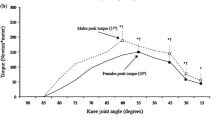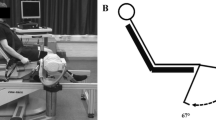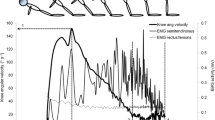Summary
This study assessed maximum eccentric (ECC) and concentric (CON) torque of quadriceps (QUAD) and hamstring (HAM) muscle groups in healthy females (n=13) and males (n=27). Peak torques (PT) of bilateral muscle actions were recorded at constant angular velocities of 0.52, 1.57 and 2.61 rad·s−1. The QUADcon and HAMcon PT decreased (p<0.05) with increasing angular velocity. The QUADecc and HAMecc PT increased (p<0.05) in females, whereas QUADecc PT decreased (p<0.05) and HAMecc PT showed no change in males. In general, ECC PT was higher (p<0.05) than CON PT and QUAD PT was higher (p<0.05) than HAM PT, for any given angular velocity. Males displayed higher (p<0.05) PT than females but when PT were adjusted for body mass the sex differences in QUADcon and HAMcon were reduced (p<0.05), whereas the differences in QUADecc and HAMecc were abolished. The CON and ECC PT were, on average, 60% and 41% greater, respectively, in males than in females. The corresponding differences, when adjusted for body mass, were 23% and 8%. ECC:CON PT for QUAD were higher (p<0.05) in females than in males. CON and ECC HAM:QUAD PT ratio increased (p<0.05), as a function of velocity. This study suggests, that bilateral ECC PT is higher than CON PT and CON HAM:QUAD PT ratio is higher than ECC HAM:QUAD PT ratio. Moreover, females and males display different ECC torque-velocity patterns, whereas CON torquevelocity patterns are similar and females possess greater QUADecc PT relative to QUADcon PT than males.
Similar content being viewed by others
References
Asmussen E, Hansen O, Lammert O (1965) The relation between isometric and dynamic muscle strength in man. Commun Dan Nat Assoc 20:3–11
Campbell DE, Glenn W (1982) Rehabilitation of knee flexor and knee extensor muscle strength in patients with meniscectomies, ligamentous repairs, and chondromalacia. Phys Ther 62:10–15
Costain R, Williams AK (1984) Isokinetic quadriceps and hamstring torque levels of adolescent, female soccer players. J Orthop Sports Phys Ther 5:196–200
Doss WS, Karpovich PV (1965) A comparison of concentric, eccentric and isometric strength of elbow flexors. J Appl Physiol 20:351–353
Farrell M, Richards JG (1986) Analysis of the reliability and validity of the kinetic communicator exercise device. Med Sci Sports Exerc 18:44–49
Fenn WO, Marsh BS (1935) Muscular force at different speeds of shortening. J Physiol (Lond) 85:277–297
Figoni SF, Christ CB, Massey BH (1988) Effects of speed, hip and knee angle, and gravity on hamstring to quadriceps torque ratios. J Orthop Sports Phys Ther 9:287–291
Fillyaw M, Bevins T, Fernandez L (1986) Importance of correcting isokinetic peak torque for the effect of gravity when calculating knee flexor to extensor muscle ratios. Phys Ther 66:23–31
Gregor RJ, Edgerton VR, Perrine JJ, Campion DS, DeBus C (1979) Torque-velocity relationships and muscle fiber composition in elite female athletes. J Appl Physiol 47:388–392
Griffin JW (1987) Differences in elbow flexion torque measured concentrically, eccentrically, and isometrically. Phys Ther 67:1205–1208
Grimby G, Gustavsson E, Peterson L, Renström P (1980) Quadriceps function and training after knee ligament surgery. Med Sci Sports Exerc 12:70–75
Highgenboten CL, Jackson AW, Meske NB (1988) Concentric and eccentric torque comparisons for knee extension and flexion in young adult males and females using the Kinetic Communicator. Am J Sports Med 16:234–237
Hill AV (1938) The heat of shortening and the dynamic constants of muscle. Proc R Soc Lond [Biol] 126:136–195
Klopfer DA, Greij SD (1988) Examining quadriceps/hamstrings performance at high velocity isokinetics in untrained subjects. J Orthop Sports Phys Ther 10:18–22
Komi PV (1973) Measurement of the force-velocity relationship in human muscle under concentric and eccentric contractions. In: Med Sport, Vol 8. Biomechanics III, Karger, Basel, pp 224–229
Komi PV (1979) Neuromuscular performance: factors influencing force and speed production. Scand J Sports Sci 1:2–15
Komi PV, Bosco C (1978) Utilization of stored elastic energy in leg extensor muscles by men and women. Med Sci Sports 10:261–265
Komi PV, Rusko H (1974) Quantitative evaluation of mechanical and electrical changes during fatigue loading of eccentric and concentric work. Scand J Rehab Med [Suppl] 3:121–126
Komi PV, Viitasalo JT (1977) Changes in motor unit activity and metabolism in human skeletal muscle during and after repeated eccentric and concentric contractions. Acta Physiol Scand 100:246–254
Maughan RJ, Watson JS, Weir J (1983) Strength and cross-sectional area of human skeletal muscle. J Physiol (Lond) 338:37–49
Nisell R (1985) Mechanics of the knee. A study of joint and muscle load with clinical applications. Acta Orthop Scand 56:1–42 [Suppl 216]
Olson VL, Smidt GL, Johnston RC (1972) The maximum torque generated by the eccentric, isometric, and concentric contractions of the hip abductor muscles. Phys Ther 52:149–157
Rizzardo MR, Wessel J, Bay G (1988) Eccentric and concentric torque and power of the knee extensors of females. Can J Sport Sci 13:166–169
Rodgers KL, Berger RA (1974) Motor-unit involvement and tension during maximum, voluntary concentric, eccentric, and isometric contractions of the elbow flexors. Med Sci Sports 6:253–259
Secher NH, Rörsgaard S, Secher O (1976) Contralateral influence on recruitment of Type I muscle fibres during maximum voluntary extension of the legs. Acta Physiol Scand 96:20A-21A
Singh M, Karpovich PV (1966) Isotonic and isometric forces of forearm flexors and extensors. J Appl Physiol 21:1435–1437
Snedecor GW, Cochran WG (1967) Statistical methods. Iowa State University Press, Iowa, USA
Stafford MG, Grana WA (1984) Hamstring/quadriceps ratios in college football players: a high velocity evaluation. Am J Sports Med 12:209–211
Tesch PA, Lindborg BPO, Colliander EB (1989) Evaluation of a dynamometer measuring torque of uni- and bilateral concentric and eccentric muscle action. Clin Physiol (in press)
Thorstensson A, Grimby G, Karlsson J (1976) Force-velocity relations and fiber composition in human knee extensor muscles. J Appl Physiol 40:12–16
Tihanyi J, Apor P, Fekete Gy (1982) Force-velocity-power characteristics and fiber composition in human knee extensor muscles. Eur J Appl Physiol 48:331–343
Wilkie DR (1950) The relation between force and velocity in human muscle. J Physiol (Lond) 110:249–280
Wyatt MP, Edwards AM (1981) Comparison of quadriceps and hamstring torque values during isokinetic exercise. J Orthop Sports Phys Ther 3:48–56
Yates JW, Kamon E (1983) A comparison of peak and constant angle torque-velocity curves in fast and slow-twitch populations. Eur J Appl Physiol 51:67–74
Author information
Authors and Affiliations
Rights and permissions
About this article
Cite this article
Colliander, E.B., Tesch, P.A. Bilateral eccentric and concentric torque of quadriceps and hamstring muscles in females and males. Europ. J. Appl. Physiol. 59, 227–232 (1989). https://doi.org/10.1007/BF02386192
Accepted:
Issue Date:
DOI: https://doi.org/10.1007/BF02386192




